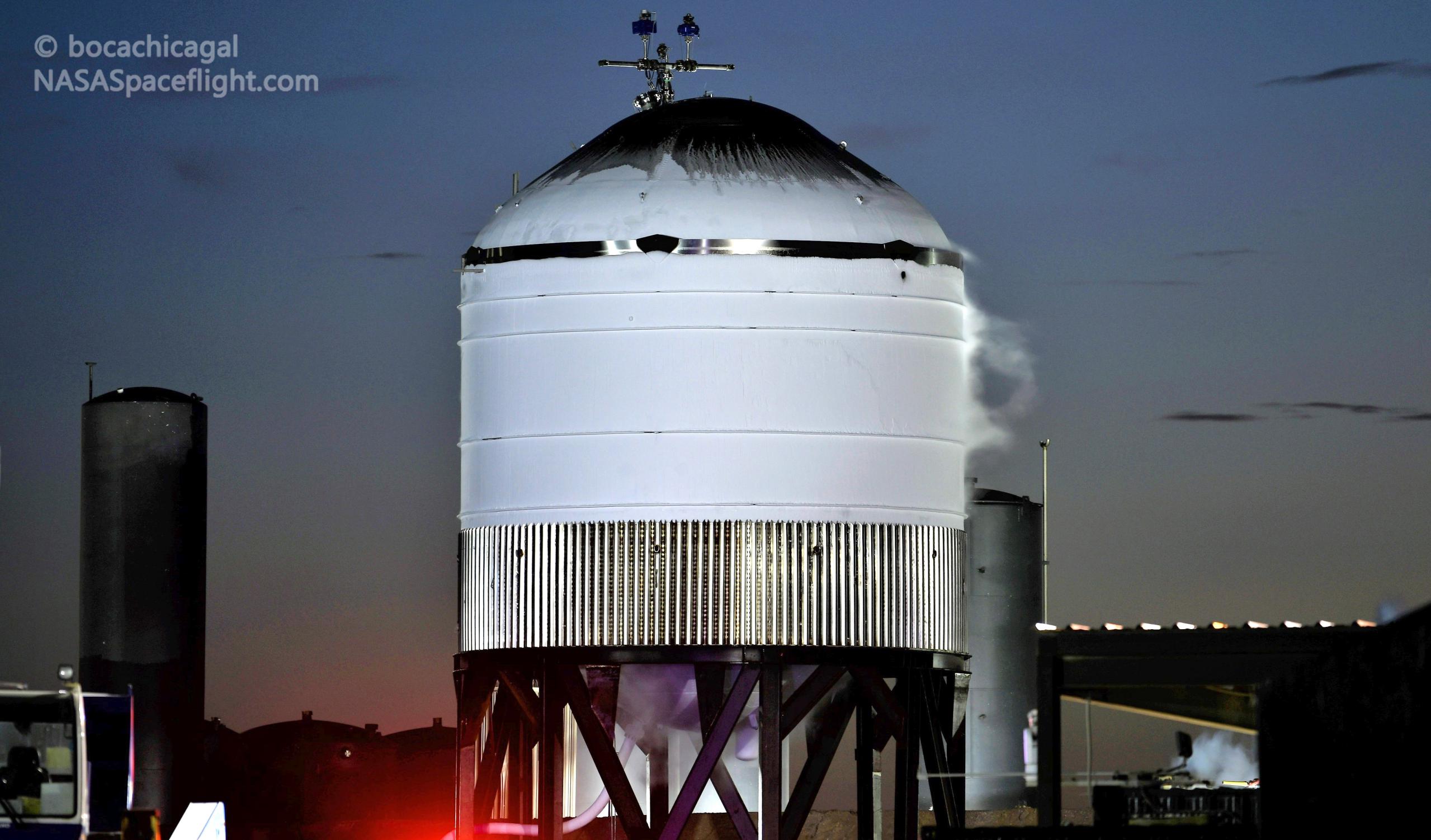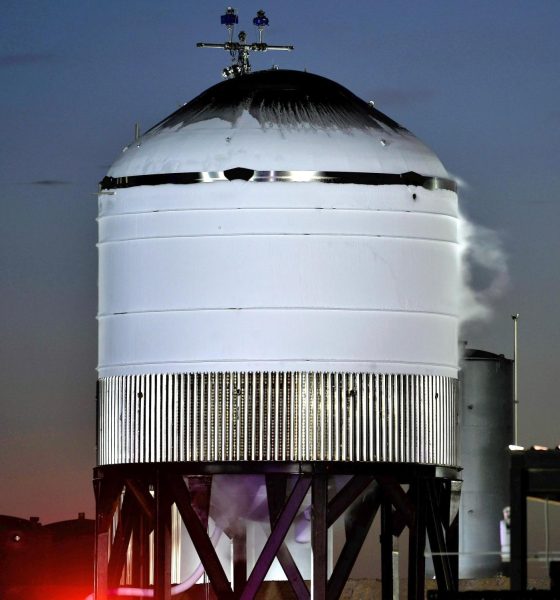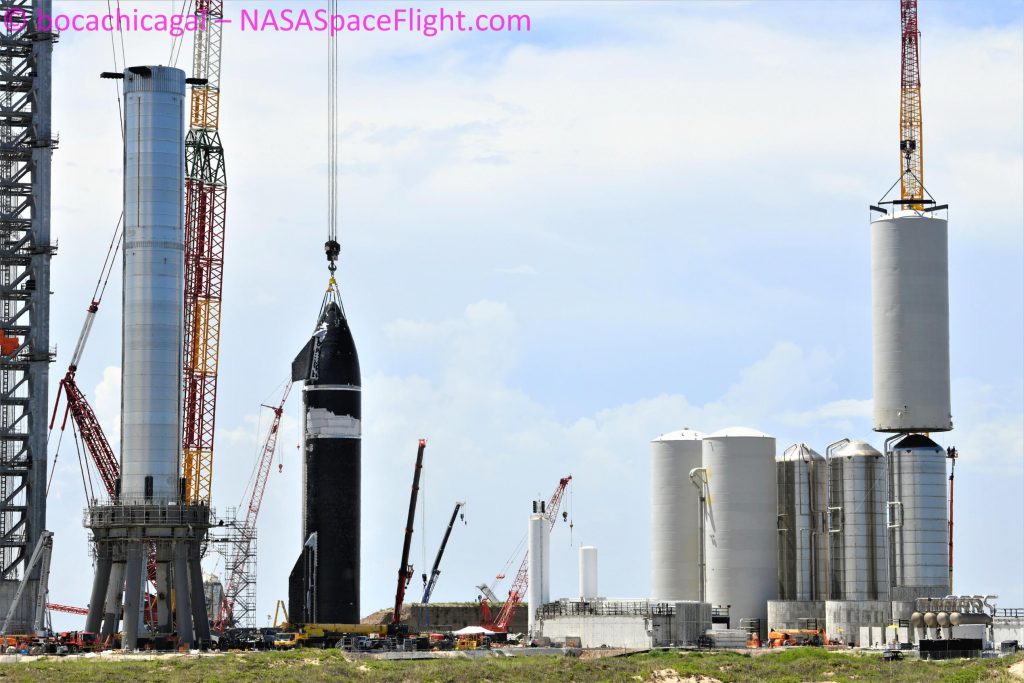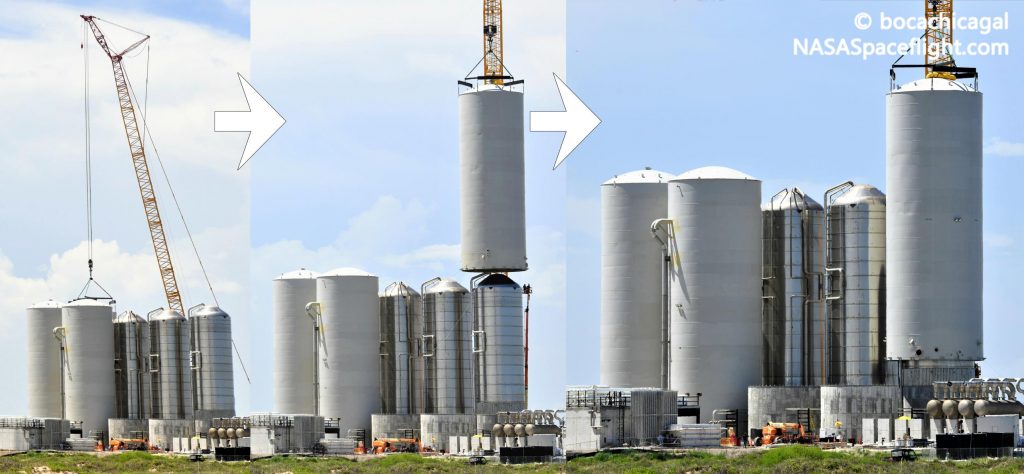

News
SpaceX’s odd Starbase propellant storage tank prototype passes first test
Likely to the relief of many, SpaceX appears to have successfully tested a prototype of the custom-built Starbase propellant storage tanks that will eventually hold thousands of tons of fuel and oxidizer.
For reasons unknown, SpaceX’s built its first ground support equipment (GSE) ‘test tank’ – a subscale prototype designed to quickly verify basic production quality and design goals – months after it began mass-producing operational storage tanks. In fact, of the seven total GSE tanks expected to be built, SpaceX has already completed seven, installed five, and scrapped one. Known as GSE4, SpaceX actually used modified parts of that scrapped tank to assemble the GSE test tank that first rolled to Starbase’s launch (and test) facilities on August 23rd.
Two days later, SpaceX subjected the small tank to its first test.
Given that SpaceX appears to have almost retroactively assembled the GSE4 test tank after building the final products, the results from its testing were always going to be significantly more anxiety-inducing than any of the more than half-dozen other tanks the company has tested in the last year and a half. Having already fabricated, assembled, or even installed six of seven planned GSE tanks, the discovery of major issues during testing could potentially cause months of delays by forcing SpaceX to perform lengthy repairs or even fully scrap all six existing tanks and start over.

Thankfully, at least for the time being, it appears that SpaceX can write off those potential worst-case scenarios. On August 25th, SpaceX took advantage of a test window initially believed to be for Starship S20 and put the cobbled-together GSE4 tank through its paces for the first time. As with previous test tanks, all SpaceX can really do is fill the prototype with liquid nitrogen (LN2), a non-flammable alternative to liquid oxygen or methane propellant that is approximately as cold and heavy. As a storage tank prototype, though, GSE4 has no need for hydraulic ram setups used to simulate the thrust of Raptor engines on several previous prototypes.
As such, one or several cryogenic proof tests were all that were ever really in GSE4’s future. On GSE4’s first test, SpaceX performed a more or less normal cryogenic proof, completely filling the tank with LN2, closing its vents, and then allowing the natural process of LN2 boiloff to raise the tank to the desired test pressure. However, unlike other test tanks, GSE4 never actually appeared to reopen its main vents. In fact, SpaceX may have never actually drained liquid nitrogen from the test tank, instead simply letting it slowly warm up and boil off into gas that was seemingly managed and vented by ground systems instead of the tank itself.
As a result, GSE4 stayed frosty (indicating a significant amount of remaining liquid nitrogen) for more than eight hours, strongly implying that it was either very slowly drained or simply allowed to warm up naturally. Given that large cryogenic storage tanks really don’t have to be significantly pressurized to complete their job, it’s possible that GSE4’s first test was primarily meant to verify the basic structural integrity of a tank that’s slightly different than those on Starship and, more importantly, test a different method of pressure and fluid management where most of that work is done by external, permanent systems on the ground.
That’s exactly what one might expect of rocket tankage slightly modified to serve as ground storage tanks. SpaceX’s GSE tanks never have to act as self-contained units and can instead rely almost entirely on separate systems.

Aside from verifying that that slightly different method of tank operations works as expected, GSE4’s first test likely also allowed SpaceX to better characterize the thermal properties of the thin steel skin and domes that are Starship and GSE tanks. Unlike GSE4, operational GSE tanks will be enclosed inside 12m (~40 ft) wide ‘cryo shells’ designed to insulate their cryogenic contents, but the insulative properties of the inner tanks (or the lack there of, rather) will still determine how well that insulation works and how much is actually needed to reach the desired boiloff rates. A contractor hired by SpaceX has already completed all seven cryo shells, so any results gathered from GSE4 will obviously be more of a check than a developmental test, but data is still data.

News
Tesla starts showing how FSD will change lives in Europe
Local officials tested the system on narrow country roads and were impressed by FSD’s smooth, human-like driving, with some calling the service a game-changer for everyday life in areas that are far from urban centers.

Tesla has launched Europe’s first public shuttle service using Full Self-Driving (Supervised) in the rural Eifelkreis Bitburg-Prüm region of Germany, demonstrating how the technology can restore independence and mobility for people who struggle with limited transport options.
Local officials tested the system on narrow country roads and were impressed by FSD’s smooth, human-like driving, with some calling the service a game-changer for everyday life in areas that are far from urban centers.
Officials see real impact on rural residents
Arzfeld Mayor Johannes Kuhl and District Administrator Andreas Kruppert personally tested the Tesla shuttle service. This allowed them to see just how well FSD navigated winding lanes and rural roads confidently. Kruppert said, “Autonomous driving sounds like science fiction to many, but we simply see here that it works totally well in rural regions too.” Kuhl, for his part, also noted that FSD “feels like a very experienced driver.”
The pilot complements the area’s “Citizen Bus” program, which provides on-demand rides for elderly residents who can no longer drive themselves. Tesla Europe shared a video of a demonstration of the service, highlighting how FSD gives people their freedom back, even in places where public transport is not as prevalent.
What the Ministry for Economic Affairs and Transport says
Rhineland-Palatinate’s Minister Daniela Schmitt supported the project, praising the collaboration that made this “first of its kind in Europe” possible. As per the ministry, the rural rollout for the service shows FSD’s potential beyond major cities, and it delivers tangible benefits like grocery runs, doctor visits, and social connections for isolated residents.
“Reliable and flexible mobility is especially vital in rural areas. With the launch of a shuttle service using self-driving vehicles (FSD supervised) by Tesla in the Eifelkreis Bitburg-Prüm, an innovative pilot project is now getting underway that complements local community bus services. It is the first project of its kind in Europe.
“The result is a real gain for rural mobility: greater accessibility, more flexibility and tangible benefits for everyday life. A strong signal for innovation, cooperation and future-oriented mobility beyond urban centers,” the ministry wrote in a LinkedIn post.
News
Tesla China quietly posts Robotaxi-related job listing
Tesla China is currently seeking a Low Voltage Electrical Engineer to work on circuit board design for the company’s autonomous vehicles.

Tesla has posted a new job listing in Shanghai explicitly tied to its Robotaxi program, fueling speculation that the company is preparing to launch its dedicated autonomous ride-hailing service in China.
As noted in the listing, Tesla China is currently seeking a Low Voltage Electrical Engineer to work on circuit board design for the company’s autonomous vehicles.
Robotaxi-specific role
The listing, which was shared on social media platform X by industry watcher @tslaming, suggested that Tesla China is looking to fill the role urgently. The job listing itself specifically mentions that the person hired for the role will be working on the Low Voltage Hardware team, which would design the circuit boards that would serve as the nervous system of the Robotaxi.
Key tasks for the role, as indicated in the job listing, include collaboration with PCB layout, firmware, mechanical, program management, and validation teams, among other responsibilities. The role is based in Shanghai.
China Robotaxi launch
China represents a massive potential market for robotaxis, with its dense urban centers and supportive policies in select cities. Tesla has limited permission to roll out FSD in the country, though despite this, its vehicles have been hailed as among the best in the market when it comes to autonomous features. So far, at least, it appears that China supports Tesla’s FSD and Robotaxi rollout.
This was hinted at in November, when Tesla brought the Cybercab to the 8th China International Import Expo (CIIE) in Shanghai, marking the first time that the autonomous two-seater was brought to the Asia-Pacific region. The vehicle, despite not having a release date in China, received a significant amount of interest among the event’s attendees.
Elon Musk
Elon Musk and Tesla AI Director share insights after empty driver seat Robotaxi rides
The executives’ unoccupied tests hint at the rapid progress of Tesla’s unsupervised Robotaxi efforts.

Tesla CEO Elon Musk and AI Director Ashok Elluswamy celebrated Christmas Eve by sharing personal experiences with Robotaxi vehicles that had no safety monitor or occupant in the driver’s seat. Musk described the system’s “perfect driving” around Austin, while Elluswamy posted video from the back seat, calling it “an amazing experience.”
The executives’ unoccupied tests hint at the rapid progress of Tesla’s unsupervised Robotaxi efforts.
Elon and Ashok’s firsthand Robotaxi insights
Prior to Musk and the Tesla AI Director’s posts, sightings of unmanned Teslas navigating public roads were widely shared on social media. One such vehicle was spotted in Austin, Texas, which Elon Musk acknowleged by stating that “Testing is underway with no occupants in the car.”
Based on his Christmas Eve post, Musk seemed to have tested an unmanned Tesla himself. “A Tesla with no safety monitor in the car and me sitting in the passenger seat took me all around Austin on Sunday with perfect driving,” Musk wrote in his post.
Elluswamy responded with a 2-minute video showing himself in the rear of an unmanned Tesla. The video featured the vehicle’s empty front seats, as well as its smooth handling through real-world traffic. He captioned his video with the words, “It’s an amazing experience!”
Towards Unsupervised operations
During an xAI Hackathon earlier this month, Elon Musk mentioned that Tesla owed be removing Safety Monitors from its Robotaxis in Austin in just three weeks. “Unsupervised is pretty much solved at this point. So there will be Tesla Robotaxis operating in Austin with no one in them. Not even anyone in the passenger seat in about three weeks,” he said. Musk echoed similar estimates at the 2025 Annual Shareholder Meeting and the Q3 2025 earnings call.
Considering the insights that were posted Musk and Elluswamy, it does appear that Tesla is working hard towards operating its Robotaxis with no safety monitors. This is quite impressive considering that the service was launched just earlier this year.








